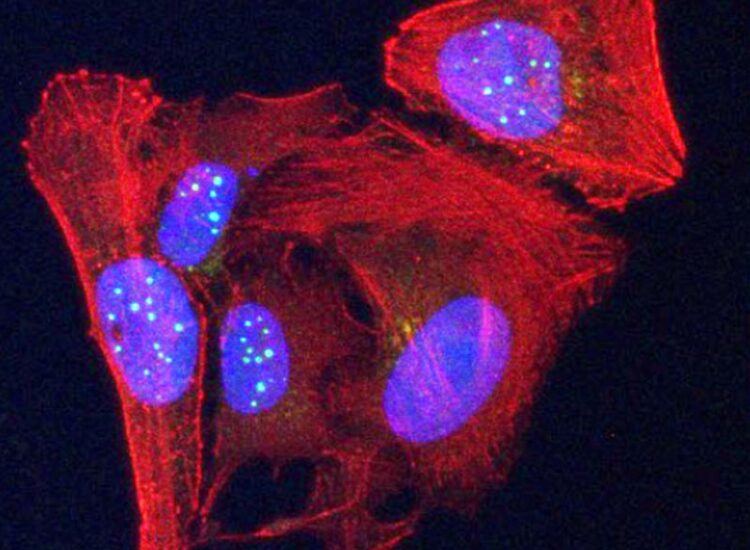Stunning discovery, find new protein activity in telomeres

Newly discovered telomeric protein VR, (green spheres) is seen accumulating in nuclei (blue ovals) in human osteosarcoma cancer cells stained in red.
Credit: Griffith Lab, UNC Lineberger
UNC School of Medicine researchers Jack Griffith, PhD, and Taghreed Al-Turki, PhD, found that telomeres at the tips of chromosomes contain sufficient genetic information to produce two small proteins with potentially potent biological properties.
Once thought incapable of encoding proteins due to their simple monotonous repetitions of DNA, tiny telomeres at the tips of our chromosomes seem to hold a potent biological function that’s potentially relevant to our understanding of cancer and aging.
Reporting in the Proceedings of the National Academy of Science, UNC School of Medicine researchers Taghreed Al-Turki, PhD, and Jack Griffith, PhD, made the stunning discovery that telomeres contain genetic information to produce two small proteins, one of which they found is elevated in some human cancer cells, as well as cells from patients suffering from telomere-related defects.
“Based on our research, we think simple blood tests for these proteins could provide a valuable screen for certain cancers and other human diseases,” said Griffith, the Kenan Distinguished Professor of Microbiology and Immunology and member of the UNC Lineberger Comprehensive Cancer Center. “These tests also could provide a measure of ‘telomere health,’ because we know telomeres shorten with age.”
Telomeres contain a unique DNA sequence consisting of endless repeats of TTAGGG bases that somehow inhibit chromosomes from sticking to each other. Two decades ago, the Griffith laboratory showed that the end of a telomere’s DNA loops back on itself to form a tiny circle, thus hiding the end and blocking chromosome-to-chromosome fusions. When cells divide, telomeres shorten, eventually becoming so short that the cell can no longer divide properly, leading to cell death.
Scientist first identified telomeres about 80 years ago, and because of their monotonous sequence, the established dogma in the field held that telomeres could not encode for any proteins, let alone ones with potent biological function.
In 2011 a group in Florida working on an inherited form of ALS reported that the culprit was an RNA molecule containing a six-base repeat which by a novel mechanism could generate a series of toxic proteins consisting of two amino acids repeating one after the other. Al-Turki and Griffith note in their paper a striking similarity of this RNA to the RNA generated from human telomeres, and they hypothesized that the same novel mechanism might be in play.
They conducted experiments – as described in the PNAS paper – to show how telomeric DNA can instruct the cell to produce signaling proteins they termed VR (valine-arginine) and GL (glycine-leucine). Signaling proteins are essentially chemicals that trigger a chain reaction of other proteins inside cells that then lead to a biological function important for health or disease.
Al-Turki and Griffith then chemically synthesized VR and GL to examine their properties using powerful electron and confocal microscopes along with state-of-the-art biological methods, revealing that the VR protein is present in elevated amounts in some human cancer cells, as well as cells from patients suffering from diseases resulting from defective telomeres.
“We think it’s possible that as we age, the amount of VR and GL in our blood will steadily rise, potentially providing a new biomarker for biological age as contrasted to chronological age,” said Al-Turki, a postdoctoral researcher in the Griffith lab. “We think inflammation may also trigger the production of these proteins.”
Griffith noted, “When you go against current thinking, you are usually wrong because you are bucking many people who’ve worked so diligently in their fields. But occasionally scientists have failed to put observations from two very distant fields together and that’s what we did. Discovering that telomeres encode two novel signaling proteins will change our understanding of cancer, aging, and how cells communicate with other cells.
“Many questions remain to be answered, but our biggest priority now is developing a simple blood test for these proteins. This could inform us of our biological age and also provide warnings of issues, such as cancer or inflammation.”
The National Institutes of Health funded this research through three grants (GM31819, ES013773, ESO31635). The UNC Viral Vector Core and the light microscopy facility at the UNC Lineberger Comprehensive Cancer Center were vital partners in this research. Jack Griffith has a joint faculty appointment in the UNC Department of Biochemistry and Biophysics.
Journal: Proceedings of the National Academy of Sciences
DOI: 10.1073/pnas.2221529120
Method of Research: Experimental study
Subject of Research: Cells
Article Title: Mammalian Telomeric RNA (TERRA) can be translated to produce valine-arginine and glycine-leucine dipeptide repeat proteins
Article Publication Date: 20-Feb-2023
Media Contact
Mark Derewicz
University of North Carolina Health Care
Mark.Derewicz@unchealth.unc.edu
Cell: 919-923-0959
All latest news from the category: Life Sciences and Chemistry
Articles and reports from the Life Sciences and chemistry area deal with applied and basic research into modern biology, chemistry and human medicine.
Valuable information can be found on a range of life sciences fields including bacteriology, biochemistry, bionics, bioinformatics, biophysics, biotechnology, genetics, geobotany, human biology, marine biology, microbiology, molecular biology, cellular biology, zoology, bioinorganic chemistry, microchemistry and environmental chemistry.
Newest articles

Innovative 3D printed scaffolds offer new hope for bone healing
Researchers at the Institute for Bioengineering of Catalonia have developed novel 3D printed PLA-CaP scaffolds that promote blood vessel formation, ensuring better healing and regeneration of bone tissue. Bone is…

The surprising role of gut infection in Alzheimer’s disease
ASU- and Banner Alzheimer’s Institute-led study implicates link between a common virus and the disease, which travels from the gut to the brain and may be a target for antiviral…

Molecular gardening: New enzymes discovered for protein modification pruning
How deubiquitinases USP53 and USP54 cleave long polyubiquitin chains and how the former is linked to liver disease in children. Deubiquitinases (DUBs) are enzymes used by cells to trim protein…



